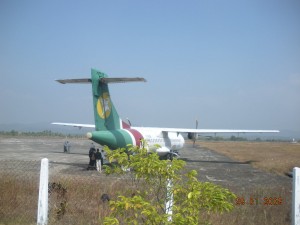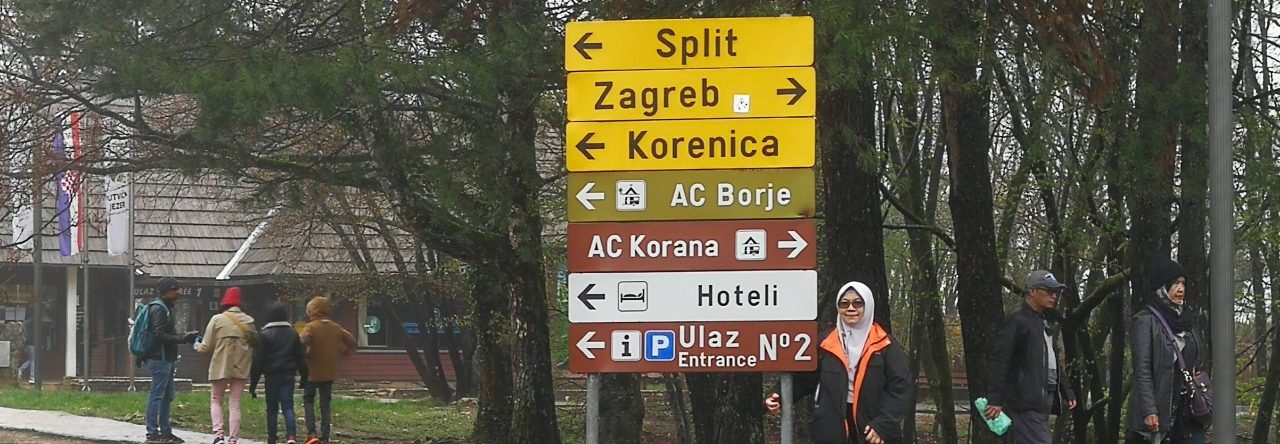(This is my first trip to Kanbauk in Southern Myanmar in January 2009. Info on places mentioned in this posting are correct at that time. Also take note that KANBAUK and DAWEI (a.k.a TAVOY) are strictly no-go areas for tourists. Tourists do not normally come here as they need special permit to enter this region. I was here because of official work).

Yangon Air flight look set to depart from Dawei airstrip to Yangon. Dawei and Kanbauk is about 30-min flight apart
My work requires me to meet people and listen to their problems. Often I need travel to remote locations, for this purpose. But who’s listening to my problems? Today I traveled to Kanbauk, some 280 miles south of Yangon to visit our staff at remote sites.
It was quite a new experience. To me both the journey is as important as the arrival.
We started at Yangon International Airport. It is a domestic terminal where airlines like Bagan Air, Yangon Airways, Mandalay Air and chartered flights call it home. It is located next to the new international terminal. Probably it was an original Yangon International Airport. Crowded and congested were not the right adjectives to describe the airport. It was rather relaxed but dull.
The airline personnel whisked us to a room at the corner of the building for a safety briefing. He turned on a video player and left without a word. A video was played. All safety features about the aircraft we were about to board were shown. Seat belt. Safety jacket. No smoking. Emergency exit doors. Bracing position in an unlikely event the plane went down abnormally. No oxygen mask though — why? Could it be they are not required or could it be they were already broken or could it be there was no oxygen cylinder on board. Don’t know.
It was a Twin Otter 300 with about 20-seater and 6 emergency exits. I have never seen emergency exits that so many for only 20 passengers.
We boarded the aircraft at 10:15 am and no other briefing was given while onboard. The stair which we climbed up into the plane – one person at one time – now turned into a door as it was folded up and slammed from outside by the pilot.
“Buckled up and we’ll be in Kanbauk in one hour twenty minutes”, said the co-pilot, before slamming the door.
He then hastily run around the plane and got in the cockpit thru one of six emergency exits. His companion revved up the engines until propellers reached some speed. The plane moved to the far-end of the runway and within 10 minutes we were up there in the sky with Yangon City sprawling under our feet.
Both pilots were white men, obviously seasoned aviators and they reminded me of Harrison Ford in the movie “7-days-and-6-nights”, except that they wore their company’s white uniforms.
There were only 6 passengers in this flight from Yangon to Kanbauk on 16th January 2009. Six emergency exits. One emergency exit each. We should feel safer.
The journey was smooth nevertheless. I managed to update my blog and then dozed off. Upon reaching Kanbauk, could see the coast line of Andaman Sea. The murky sea water merged into a big river mouth in between the mountains. It was a mountainous region in Mon State in south-eastern Myanmar. Paddy fields and wooden houses occupied valleys between the mountains and dense forests. It was a cool view. The forest was virgin and seemed untouched, unlike in Malaysia where logging was regulated but not enforced. Not much logging activities noticeable from 15000 feet. The leaves were green and not so green due to dry and cold season. Gorges and plateaus made an amazing landscape. Sunlight fell on clouds and shadow created such a wonderful contrast which could only be appreciated by professional photographers.
World is just awesome. Man can only paint such scenery but who created them all? I said subhanallah – God is ever gracious.
We touched down at 11:35 am as scheduled in Kanbauk. It was a private airfield with a short runway, surrounded by forest. It was utilized by oil and gas companies personnel. The plane swayed a bit upon a hard landing. It made a U-turn when it reached furthest end of the airstrip and taxied to its parking bay next to the only building — which I discovered later served as a maintenance workshop and arrival/departure hall, three in one.
I saw a helicopter at one side of the runway, being prepared for take-off to the offshore oil platform. A white man with a Heli Union printed on his white shirt was walking to the helicopter, followed by few tough guys, some carrying some kind of toolbox. But I am not going with them to offshore today. May be other time.
Inside the building, there is a small room which made up arrival and departure hall at the same time. There were blue seats facing a main door where we just came in. A Samsung video player attached to the TV set was on the rack next to the door. Arriving passengers were ushered to the back of the room whereas departing passengers were seated to watch a safety video, the same video we watched at Yangon on how many emergency exits and where they are and stuff like that.
The wall is full of frames with various company logos. Upon close scrutiny, there were indeed Safety policies of various companies operating in and out of Kanbauk such as PCML, TEPM, Hevilift, Heli Union and others. These are all either multinational oil and gas players or service providers providing support services to the former. Obviously safety is of paramount concern in this type of business.
There was a table at the back manned by three national men in yellow coverall. One explained to us in broken but understandable English that they were doing a random alcohol and drug testing to Company employees and contractors. He added that this is a Company policies, recently approved. He handed over two forms to me — consent form and refusal form. We had to fill up one only. I filled up the former. After all, I was part of that system.
Details were required by the form. The medication you took in the last 6 hours. I put down zinc, signed and handed back the form to him.
Then his assistant asked me to draw a small bottle from the plastic bag full of sample bottles. He showed me the toilet and asked me to fill up to the level indicated on the bottle with my urine. The bottle has 5 stripes one for each type of drug to be tested. Cocaine, marijuana, anti-depressant drugs are some of those. Could not remember the scientific names he mentioned. My female traveling companion teased them whether could she be tested for pregnancy as well. I said – just add another stripe. We all laughed. But men in yellow did not. They were serious like rock.
I got in the toilet, following their instruction like a first-grader on the first day at school.
Five minutes later, the test result was out. I was tested negative. Now we could proceed to the waiting four wheel drive vehicle. It was a dusty Toyota Land Cruiser with big Hakook tyres and tall antenna perched on the front bumper.
The road was a dirt road so dusty so much so that green leaves turn red, being covered with dust. It seemed it never rained here for ages. We passed by a local village and a school painted in white and green. Children were having recess as some were playing football in their longyis. To me, these kids are the real investment. This country and this company need them to operate all our assets in 20-years time.
Fifteen minutes later, we reached our destination — a pipeline control center, fortified area sandwiched in between southern Myanmar mountain ranges. As the name implies, the center controls the transmission of natural gas from offshore gas field to Thailand.
The security fence was so high, seemingly as high as the tallest coconut trees. The security check was thorough. Our vehicle’s undercarriage was inspected using portable detector. Bags were searched for prohibited items. No lighters, mobile phone and camera allowed. We walked up some 50 meters to the site manager’s office. He was a medium-built white man. I found it later he is a Scottish.
The staff gathered in a meeting room — about 30 of them all in their working apparel. The whole idea of my trip is to communicate HR matters to them and at the same time getting their feedbacks. I shared the HR Department structure and roles and functions. My colleague shared the recruitment process and training procudures. Then we open the floor for question and answer session.
It was the first time I met my staff at this site. Except one or two or three, the rest of the staff in this shift are local, i.e. Burmese. They must have been wondering who the new HR Manager is? Will he be different than the previous one? Will he listen more to staff problem? Will he take action quick enough? Will he visit us more often? I guess the writing on the wall indicated that they were so eager to meet me and I was equally eager to meet them. The pressure was mounting on me to show that I was the better one. Me and my staff delivered what we were supposed to deliver and the dreadful part started. Question and answer or in short Q&A. Questions came to me like bullets which could not wait. From the the most basic such as “why I did not qualify for long service award this year” to the hardest one like “my salary is hitting ceiling already, can you share the salary band?”.
The session took almost 6 hours with small breaks, and ended at about 8pm. The evening breeze was really cold outside when I walked to my dormitory to retire for the day. It was a room with two double-storey bed, a TV set, two cupboards, a coffee maker and an attached toilet. Staff stayed in the same dormitory within the compound. Their world is within this heavily fenced compound. A cafetaria. A soccer field. A run-down tennis court. A dormitory. Even a small room containing Buddha statue. All a man could ever need can be found here. Minus family and mobile phone signal.

